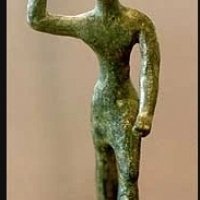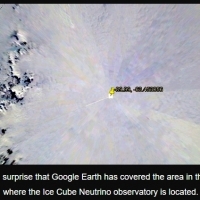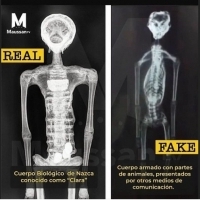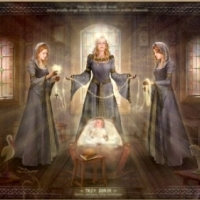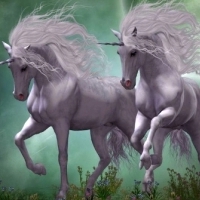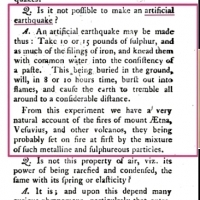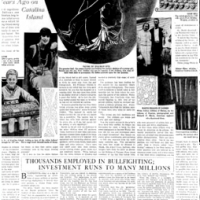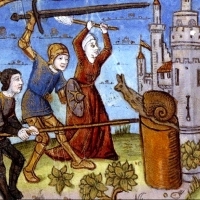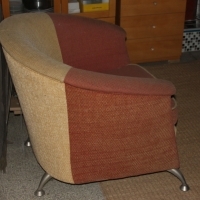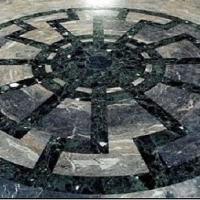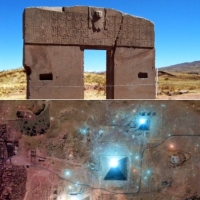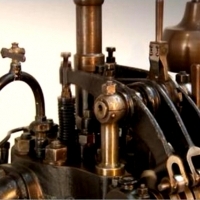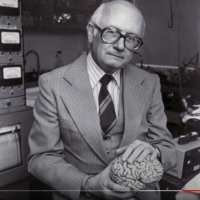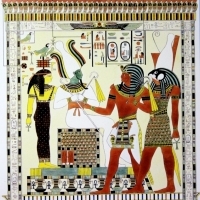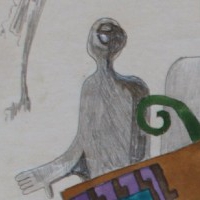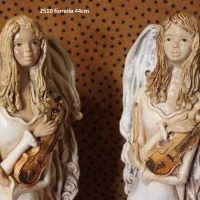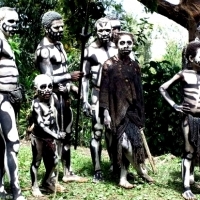0 : Odsłon:
Are the Anunnaki real? Are they aliens? Or are they part of a bigger picture?
The “Anunnaki” are the major players in a paradigm making its way into popular folklore, via the work of the late Zecharia Sitchin, an economist by education and profession, and the author of several best-selling books, including Genesis Revisited, that explore ancient mythology and the mysterious megalithic ruins found around the globe. These various books also seek to demonstrate that there was in ancient times an extraterrestrial race that genetically manipulated mankind for various reasons.
The Sitchin thesis (“Sitchinism”), now embraced by numerous other writers, who have incorporated it into what is apparently a new worldview, essentially asserts that these ancient Sumero-Babylonian gods, the Anunnaki, are aliens from the planet Nibiru (Sitchin’s “12th Planet”), which passes by the earth every 3,500 years or so, at which time they planet-hop to the earth and create mischief.
Although the idea of the ancient gods being aliens may seem novel, the tendency to make the gods of old into “real people” or “flesh and blood” is not at all new, dating to before the time of the Greek historian Herodotus (5th c. BCE) and developed by the Greek philosopher Euhemeros or Evemeras (c. 300 BCE). This tendency is called, in fact, “euhemerism” or “evemerism,” which claims that the numerous gods of various cultures were not “mythical” but were in reality kings, queens, warriors and assorted heroes whose lives were turned into fairytales with the addition of miraculous details to their biographies. The current Anunnaki thesis is a modern version of evemerism, although it seeks to explain the miracles as not fabulous “additions” to the tales but genuine attributes of advanced extraterrestrials.
Unfortunately for those who would wish to see concrete evidence of such exciting notions as extraterrestrial visitation in Earth’s remote past, the Anunnaki will not be the place to look, as the true nature of these various gods and goddesses was already known long before the era of modern revisionism.
Ancient Anunnaki Astronaut Theory:
The tireless researcher Charles Fort was widely known as the chronicler of what are now called “Forteana,” bizarre anomalies and mysteries that throw the current perception of reality on its ear, whether it be religious or scientific. In an attempt to explain these anomalies, which include weird stories or “myths” and enormous, astonishing ruins worldwide, a number of people, including Swiss writer Erich von Daniken and Zecharia Sitchin, have created the “ancient astronaut theory,” which dictates that alien visitors have been influencing human life for thousands if not millions of years, even to the point of genetic manipulation. von Daniken, it should be recalled, was one of the first moderns to put forth the ancient astronaut theory and was widely ridiculed and vilified for his observations.
Mayan
Because of Sitchin’s apparent scholastic training, he becomes more credible for many, even though he is one of those renegades not scholastically trained in his field. Furthermore, it should be noted that neither man came up with the ancient astronaut theory, which was largely developed by a German occultic society, for one, during the 19th century.
Supporters (“Sitchinites”) claim that Sitchin is one of the few people who read the Sumerian language and that because he can read Sumerian, he must be interpreting the data properly. The assertion that he is one of the few scholars of Sumerian is not true. Moreover, the idea that someone may be able to read a language and therefore can interpret its data properly is a specious argument, because the one certainly does not guarantee the other. Years before Sitchin, biblical and Dead Sea scrolls scholar John Allegro studied Sumerian intimately and came to very different conclusions: To wit, that many of the words revolved around sex and drugs. Hence, it is not the “mere” ability to read the Sumerian that will produce an accurate rendering of it.
Biblical Bias?
Like so many other paradigms that make it into popular culture, the alien astronaut theory has been agenda-driven. In fact, it seems that the most recent attempt may be prompted by the same type of motivation that produced the Bible, a chronicle largely consisting of the plagiarized myths of other cultures that were reconstituted as “humans” of a particular ethnicity. It appears that the Anunnaki thesis has now led to the conclusion that, while the Bible is not infallible, its god Yahweh is valid and its various characters are the superhuman alien-hybrid progenitors of “the chosen.”
In reality, there was no reason to recreate the ancient gods as aliens or humans, because the ancients themselves were quite clear about what it was exactly they were worshipping and fancifully describing in epic poetry. The speculation is not needed, as, for example, the Sumero-Babylonians themselves said that the gods were the planets, not people, and that their stories were myths representing personifications of these bodies.
It is believed that by “dismissing” the myths of the ancients as myths, we are somehow robbing them of their “history.” This claim is ludicrous, as it is those who insist that there are no myths who are actually defaming the ancients. It seems as if everyone has already forgotten the work of the learned and esteemed mythologist Joseph Campbell. Campbell knew that major biblical tales, such as that of Moses and the Exodus, were mythical. In his book Occidental Mythology, following a discussion of the Bible, Campbell turns to the “Gods and Heroes of the European West,” and says, with apparent resentment:
“Fortunately, it will not be necessary to argue that Greek, Celtic or Germanic myths were mythological. The peoples themselves knew they were myths, and the European scholars discussing them have not been overborne by the idea of something uniquely holy about their topic.”
Perhaps mythology is simply not as exciting as the UFOlogical paradigm, whereby ancient astronauts were buzzing all over the place, being worshipped for their extraordinary capacities. However, the desire to see such a “history” often seems to be coming from exposure as a youth to comic books and sci-fi movies—and even the History Channel these days, featuring “Ancient Aliens” shows!
Astrotheology of the Ancients:
The ancients were not the dark and dumb rabble commonly portrayed. They were, in fact, highly advanced. As such, they developed over a period of many thousands of years a complex astronomical/ astrological system that incorporated the movements and qualities of numerous celestial bodies, which could be called the “celestial mythos.”
The celestial mythos is found around the globe in astonishing uniformity. In fact, it served as the manner by which life on Earth was ordered, as it contained information crucial to life, such as the movements and interrelationship of the sun and moon. Without the mythos, no people would have been able to become sea-faring, and planting and harvesting would have been difficult. And the mythos needed no alien intervention to be developed by humans, nor did it need moderns to come along and reinterpret it contrary to what its creators intended.
For example, the Anunnaki play a part in the mythos, but they are not “people,” human or otherwise. The Anunnaki, in general, represent the seven “nether spheres” and guardians of the seven “gates” through which the “sun of God” passes into the netherworld or darkness. They are also the “tutelary spirits of the earth.” So, immediately we encounter a problem which reveals that what Sitchin is putting forth is not what the ancients themselves said of the traditions they themselves apollochariot developed. Like so many before him, Sitchin also wants to make the main character of the celestial mythos, the sun, into a person.
Actually, he wants to make it into several extraterrestrials. These various gods found around the globe, such as Apollo, Osiris, Horus, Krishna, Hercules, Jesus and Quetzalcoatl, are not people or aliens but personifications of the solar hero, as was stated by the peoples who created them. The ancients were not so dumb that they mistook planets for people, even though they personified those planets and, where the knowledge or gnosis of the mythos was lost, they hoped for “the incarnation,” or the carnalization or appearance of a “god.” There is no need to recreate the wheel here by speculating upon what the ancients “really” meant.
The Anunnaki and Assorted Other Characters:
Contrary to popular belief, the Sumerian culture has been known for centuries and did not appear suddenly out of nowhere with the discovery of the cuneiform tablets found at Ur, capitol of Sumeria, for example. If anything, the tablets and others verified what we already knew about Sumeria from its inheritors, the Akkadians and Assyro-Babylonians. The Sumerians were not a lost civilization, except that their older physical remains such as at Ur had not been remembered through the ages but were rediscovered only in the mid-19th century. Their mythology and culture were fairly well preserved in the succeeding civilizations: For instance, some 300,000 tablets of the Babylonians have been found thus far, which include much commentary on their gods.
The main characters in the Sumero-Babylonian religion/mythology are Enlil/Ellil, Utu/Shamash, Marduk/Merodach, Gilgamesh, Nanna/Sin, Inanna/Ishtar, Ea/Enki and Dumuzi/Tammuz. A number of these deities are in the class called “Anunnaki” and/or “Igigi.” The Anunnaki are numbered variously: 7, 50 and 900.
None of these characters is a historical person, as, again, the Sumero-Babylonians correctly identified their own gods as being the “planets,” which, of course, included the sun and the moon to the ancients. Says the Catholic Encyclopedia regarding Babel:
“The storied tower of Birs Nimrud counts seven of these quadrangular platforms painted in seven colors, black, white, yellow, blue, scarlet, silver and gold, and in the same order sacred to the stellar gods, Adar (Saturn), Ishtar (Venus), Merodach (Jupiter), Nebo (Mercury), Nergal (Mars), Sin (the Moon), Shamash (the Sun).”
The “king of the Anunnaki,” Enlil is the storm/wind god, also essentially the same as the later Bel or Baal, the Canaanite sun god/solar hero. Enlil and Ninlil give birth to the moon god Nanna, “a major astral deity of the Sumerians,” who was called “Sin” in Babylonian. Sin is the same moon god encamped at Mt. Sinai, as well as worshipped at Ur and Harran, where purportedly lived the mythical Abraham, progenitor of the Hebrews, who “borrowed” many of their gods (Elohim) from Mesopotamia (and Canaan, Egypt, etc.). Obviously, neither the moon nor “his parents” are real persons/aliens; nor are the rest. Regarding Enlil/Bel, the Encyclopedia Britannica says:
(Akkadian), Sumerian Enlil, Mesopotamian god of the atmosphere and a member of the triad of gods completed by Anu (Sumerian An) and Ea (Enki). Enlil meant ‘Lord Wind’- both the hurricane and the gentle winds of spring were thought of as the breath issuing from his mouth, and eventually as his word or command [cf. Christian “logos” (John 1:1)]. He was sometimes called Lord of the Air.
“Although An was the highest god in the Sumerian pantheon, Enlil had a more important role: he embodied energy and force but not authority. Enlil’s cult centre was Nippur. Enlil was also the god of agriculture: the Myth of the Creation of the Hoe describes how he separated heaven and earth to make room for seeds to grow. He then invented the hoe and broke the hard crust of earth; men sprang forth from the hole. Another myth relates Enlil’s rape of his consort Ninlil (Akkadian Belit), a grain goddess, and his subsequent banishment to the underworld. This myth reflects the agricultural cycle of fertilization, ripening and winter inactivity.
“The name of his Akkadian counterpart, Bel, is derived from the Semitic word baal, or “lord.” Bel had all the attributes of Enlil, and his status and cult were much the same. Bel, however, gradually came to be thought of as the god of order and destiny. In Greek writings references to Bel indicate this Babylonian deity and not the Syrian god of Palmyra of the same name.”
Although there were many Baalim, the singular Baal apparently came to represent the sun in the age of Taurus (c. 4500-2400 BCE), whence, it is said, comes the word “bull.”
Anunnaki : historia wymyślona po to, by odwieść nas od prawdy.
ANUNNAKI New (Reptilian) World Order – Complete History Of Reptilian Control.
Who Made the Anunnaki?
Moc złota - to dlatego Anunnaki przybyli na Ziemię. Naukowcy uwolnili moc atomów złota, ale czy ta technologia jest nowa czy stara?
Czy rasa ludzka to dzieło sumeryjskich Annunaki?
The Netherworld Seven:
: Wyślij Wiadomość.
Przetłumacz ten tekst na 91 języków
: Podobne ogłoszenia.
Kwiaty rośliny:: Mahonia
: Nazwa: Kwiaty doniczkowe ogrodowe : Model nr.: : Typ: Ogrodowe rośliny:: ozdobne : Czas dostawy: 96 h : Pakowanie: Na sztuki. : Kwitnące: nie : Pokrój: krzewiasty iglasty : Rodzaj: pozostałe : Stanowisko: wszystkie stanowiska : wymiar donicy: 9 cm do…
Dr. Steven Greer: UFO whistleblowers drop bombshell on D.C.
Dr. Steven Greer: UFO whistleblowers drop bombshell on D.C. - Secrets Antarctica station, secret space program and more Wednesday, June 14, 2023 Two day ago, Dr. Steven Greer held a stunning UFO disclosure press event at Washington's D.C. press club.…
Wyspa Gunkanjima - Nagasaki, Japonia.
Wyspa Gunkanjima - Nagasaki, Japonia. Niegdyś najgęściej zaludnione miejsce na świecie, ta wyspa jest teraz miastem duchów. NIEWIELE MIEJSC NA ŚWIECIE ma tak dziwną lub przejmującą historię jak Gunkanjima. Mała, przypominająca fortecę wyspa leży tuż przy…
Chiny są już w stanie sterować pszczołami za pomocą najlżejszego na świecie chipu mózgowego.
Chiny są już w stanie sterować pszczołami za pomocą najlżejszego na świecie chipu mózgowego. Mogą je wykorzystać do akcji ratunkowych, szpiegostwa czy operacji wojskowych. Atak roju pszczół zamiast większych i łatwiejszych do strącenia dronów?…
José Jaime Maussan pokazuje różnice między prezentowanym ciałem a tym, o którym mówią niektóre media mówiły i pokazywały.
José Jaime Maussan pokazuje różnice między prezentowanym ciałem a tym, o którym mówią niektóre media mówiły i pokazywały. Jaime Maussan udowadnia prawdziwość mumii peruwiańskich.
HEBO. Producent. Pompy przemysłowe.
Całkowicie powlekana pompa herborner.X z wbudowanym filtrem wstępnym doskonale sprawdza się w instalacjach wody basenowej oraz wszędzie tam gdzie konieczne jest zapewnienie obiegu wody za pomocą pompy ze zintegrowanym filtrem wstępnym. Dzięki uzyskaniu…
OBRZĘDY URODZENIA u SŁOWIAN.
OBRZĘDY URODZENIA u SŁOWIAN. Nasi przodkowie starannie przygotowali się na pojawienie się na tym świecie nowego członka rodziny. Odbyło się święto z okazji narodzin dziecka, które miało magiczne znaczenie, nazywane było Rodziną. Środek ciąży nazywano żywą…
Jednorożce – mit czy rzeczywistość.
Jednorożce – mit czy rzeczywistość. Znajdował się na pieczęci państwowej cara Iwana Groźnego! Jednorożec nie tylko jest bezwzględnie posłuszny dziewicom, ale jest także symbolem czystości. -biały jednorożec symbolizuje również czystość i dziewictwo oraz…
W XVIII i XIX wieku ludzie wiedzieli, jak wywołać SZTUCZNE Trzęsienie Ziemi?!
W XVIII i XIX wieku ludzie wiedzieli, jak wywołać SZTUCZNE Trzęsienie Ziemi?! I nie tylko to! Wygląda na to, że oni też wiedzieli, jak wywołać tsunami, a nawet wybuch wulkanu! „Aby wywołać sztuczne trzęsienie ziemi lub wybuch wulkanu: weź dwadzieścia…
Tajemnicze jasnoskóre olbrzymy z wyspy Catalina w Kalifornii.
Tajemnicze jasnoskóre olbrzymy z wyspy Catalina w Kalifornii. W 1896 roku, Ralph Giddeen często wędrował po okolicy w poszukiwaniu starożytnych pochówków. Według niego w latach 1919-1928 znalazł 800 indiańskich grobów, a także różne artefakty i relikwie.…
Dlaczego średniowieczne ryciny przedstawiają rycerzy walczących ze ślimakami?
Dlaczego średniowieczne ryciny przedstawiają rycerzy walczących ze ślimakami? Takie rysunki najczęściej można było spotkać na marginesach średniowiecznych ksiąg. Dwie dosyć wiarygodne teorie tłumaczące ten interesujący motyw: Pierwsza z nich należy do…
Blat granitowy : Kracyt
: Nazwa: Blaty robocze : Model nr.: : Rodzaj produktu : Granit : Typ: Do samodzielnego montażu : Czas dostawy: 96 h ; Rodzaj powierzchni : Połysk : Materiał : Granit : Kolor: Wiele odmian i wzorów : Waga: Zależna od wymiaru : Grubość : Minimum 2 cm :…
0: ഏത് ഹോം ജിം ഉപകരണങ്ങൾ തിരഞ്ഞെടുക്കേണ്ടതാണ്:
ഏത് ഹോം ജിം ഉപകരണങ്ങൾ തിരഞ്ഞെടുക്കേണ്ടതാണ്: നിങ്ങൾ ജിംനാസ്റ്റിക്സ് ഇഷ്ടപ്പെടുകയും അത് വ്യവസ്ഥാപിതമായി ചെയ്യാൻ ആഗ്രഹിക്കുകയും ചെയ്യുന്നുവെങ്കിൽ, വീട്ടിൽ സ്പോർട്സ് ചെയ്യുന്നതിന് ആവശ്യമായ ഉപകരണങ്ങളിൽ നിങ്ങൾ നിക്ഷേപിക്കണം. ഇതിന് നന്ദി, അധിക ജിം പാസുകൾ…
TODO. Producent. Opakowania kartonowe. Opakowania transportowe.
Oferta W naszej firmie nawet proste szare opakowania klapowe, dzięki unikalnemu sposobowi dystrybucji staje się czymś więcej niż produkty konkurencji. Nie sprzedajemy szarej masy kartonowej, lecz system kompleksowej obsługi, a dystrybuowane przez nas…
PILLARMACHINE. Company. Other industrial machinery, Spare parts for industrial machines.
As the leaders in woodworking machinery sales and manufacturing, Pillar Machine delivers affordable, innovative and high-quality woodworking machines to customers around the country. Pillar Machine is consistently recognized as America’s leading designer…
Nigdy nie wydmuchuj powietrza obydwoma dziurkami jednocześnie.
Mocne wydmuchanie nosa powoduje znaczny nacisk na trąbkę Eustachiusza, która łączy ucho środkowe z tylną częścią nosa. Może to prowadzić do poważnego zatkania ucha lub, w skrajnych przypadkach, pęknięcia błony bębenkowej. Jest to szczególnie niebezpieczne…
TECHSPAN. Company. Printing machines, printers, parts for printing machines, printing equipment.
HIGH QUALITY PRODUCTS Techspan Group supply high technology industrial products recognized for very high quality and innovative design. Our market leading products provide our customers with technological and economic advantages. Our five core products…
Choinka z świecidełkiem w kształcie pełzającego węża w historii pierwotnej bogini, Gai, Demeter, Cibeles, czy jakkolwiek chcesz ją nazwać.
Choinka z świecidełkiem w kształcie pełzającego węża w historii pierwotnej bogini, Gai, Demeter, Cibeles, czy jakkolwiek chcesz ją nazwać. Ona była przedstawiane jako drzewo, również jak królowa góry lub kamień, w bardzo ciekawej i bardzo aktualnej…
fotel klubowy design picasso. club picasso design chair. клуб Пикассо дизайнерское кресло. клуб дизайн стілець. क्लब पिकासो डिजाइन कुर्सी।
Parametry Stan: Używany Faktura: Nie wystawiam faktury Rodzaj: tradycyjny Kolor obicia: Wielokolorowy Kolor korpusu: Wielokolorowy Głębokość mebla: 80 cm Szerokość mebla: 97 cm Wysokość mebla: 77 cm Wysokość siedziska: 43 cm Szerokość siedziska: 55 cm…
Czarne Słońce:
Czarne Słońce: Termin Czarne Słońce (po niemiecku Schwarze Sonne), określany również jako Sonnenrad (po niemiecku „Koło Słońca”), jest symbolem o znaczeniu ezoterycznym lub okultystycznym, znanym z użycia w mistycyzmie nazistowskim. Tło historyczne. Koło…
Delikatne oczyszczanie jelit.
Delikatne oczyszczanie jelit. Ważne jest, aby zawsze utrzymywać jelita w czystości. Jak się oczyścimy? Napar z senesu i kory rokitnika. Zioła te są doskonałym łagodnym środkiem przeczyszczającym. Senes oprócz eliminowania przewlekłych zaparć pomaga przy…
mRNA-1273: Maganin Coronavirus yana shirye don gwajin asibiti:
mRNA-1273: Maganin Coronavirus yana shirye don gwajin asibiti: Maganin Coronavirus yana shirye don gwajin asibiti Kamfanin Kamfanin kere-kere na Moderna, daga Cambridge, Mass., Ya ba da sanarwar cewa allurar rigakafinsa, mRNA-1273, don kwayar cutar…
WAMAX. Producent. Artykuły biurowe, papier ksero.
WAMAX w swojej działalności zdobył ogromne doświadczenie w realizacji zamówień dla małych, średnich i dużych firm. Dla nas każdy Klient jest ważny, dlatego staramy się sprostać każdemu wyzwaniu. Po modernizacji Platformy Handlowej ON-LINE w roku 2012…
Czy to możliwe, że starożytne cywilizacje, takie jak starożytni Egipcjanie, Olmekowie, Preinkowie i Inkowie, rozszyfrowali tajemnice lewitacji.
Czy to możliwe, że wielkie starożytne cywilizacje, takie jak starożytni Egipcjanie, Olmekowie, Preinkowie i Inkowie, rozszyfrowali tajemnice lewitacji i innych technologii, które dzisiejsze społeczeństwo określiło jako niemożliwe, mitologiczne? Na naszej…
ヒアルロン酸またはコラーゲン?どの手順を選択する必要があります:
ヒアルロン酸またはコラーゲン?どの手順を選択する必要があります: ヒアルロン酸とコラーゲンは、体内で自然に生成される物質です。 25歳を過ぎると、その生産が低下することを強調する必要があります。これが、老化プロセスと皮膚がたるみ、たるみ、しわやしわが現れる理由です。それらに対抗するため、審美医学では、ヒアルロン酸またはコラーゲンを注入することにより、これらのプロセスを遅くすることができます。どちらを選ぶべきですか?これらの治療法の違いは何ですか? 美容医学-I型コラーゲン治療…
බේ ගස, බේ කොළ, බේ කොළ: ලෝරල් (ලෝරස් නොබිලිස්):1
බේ ගස, බේ කොළ, බේ කොළ: ලෝරල් (ලෝරස් නොබිලිස්): ලෝරල් ගස සුන්දර වන්නේ එහි දිලිසෙන කොළ නිසාය. දකුණු යුරෝපයේ ලෝරල් හෙජ් අගය කළ හැකිය. කෙසේ වෙතත්, ඔබ එය ඉක්මවා නොයෑමට වගබලා ගත යුතුය, මන්ද ලෝරල් ලෙසද හැඳින්වෙන නැවුම් බේ කොළ වල සුවඳ බොහෝ විට වියලූ සුවඳ ඉක්මවා…


